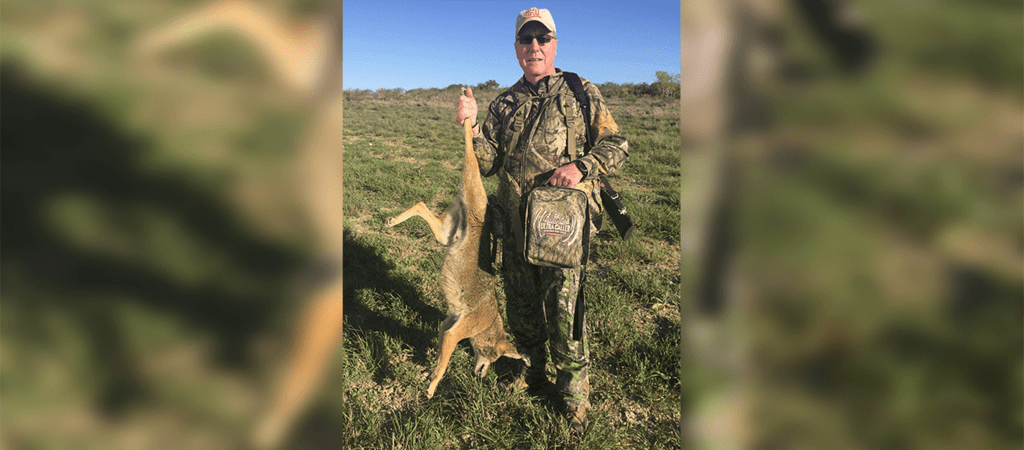
The greatest sounds for predator calling are those you can’t hear
By Gary Roberson When I first started calling critters, I didn’t know there was anything you could use other than hand calls. It wasn’t until 1967 when my cousin introduced me to recordings on cassette tapes as an alternative to blowing through a call. My first thought when I heard about using recordings of rabbits or birds in distress was that I would never have to experience another dry stand. Unfortunately, while I have had success with animal recordings, I have found they, too, are not always effective. Without a doubt, the most common question I have heard over the last 30 years is, “I can call coyotes with my hand calls, but can’t get anything to respond to an electronic caller. So what am I doing wrong?” Most of you are thinking, “Now how can that be? Most sounds on electronic callers are recordings of live animals, what can be more realistic than that?” The answer to this question is simple. You can produce a wider frequency range with a mouth call than you can with the electronic callers and speakers currently on the market. The higher frequency range generated by hand calls or diaphragms is much more realistic to the predator’s ear, therefore the response to these calls will be greater.
Sound terminology
Before we go any further into sounds and why one might be more appealing to a critter than another, let’s look at the very basic terms used when describing a sound, volume and tone. Volume is simple. We see the adjustment on the radio in your truck or on the TV remote. Volume is measured in decibels, the unit in which sound is measured. As an example, a whisper is about 15 decibels (dB) while a jet engine may reach 150 dB. Volume is obviously very important when trying to lure a critter with sound. If he cannot hear the sound, he is not coming to it. It is for this reason that most of the electronic callers on the market today will generate 120-125 dB. While volume is extremely important to calling success, so is sound quality. Sound quality or tone is measured in Hertz (Hz). Hertz is defined as a unit of frequency equal to one cycle per second or a unit used for measuring the frequency of sound waves. For example, the human can hear sounds from 64-23,000 Hz. Anything above that sound level cannot be heard, and the term for sound we cannot hear is called ultrasonic. Because we use sounds to attract predators, it is more important to find that dogs or canines can hear 67-45,000 Hz and cats or felines, 45-64,000 Hz. On the extreme range are mice that can hear 1,000 to 91,000 Hz; bats, 2,000-110,000 Hz; and Beluga whales, 1,000-123,000 Hz. I was surprised to find most birds can hear from only 250-8,000 Hz, with the owl having the keenest hearing from 200-12,000 Hz.
Recording ultrasonic sound
Now that you have an idea how sophisticated a critter’s hearing is compared to ours, it is just as important to know what the frequencies of some of the common distress sounds used for calling predators are. Until now, I did not have the ability to record and produce sounds ultrasonically, so testing was almost impossible. Recently, I purchased an ultrasonic recorder that will record up to 96,000 Hz, and recorded several popular distress sounds. In order to accurately test the frequency of these recordings, we used an oscilloscope, a device that measures the frequency of sound waves. The results we got from these tests were shocking, and gave greater proof why electronic calls are rarely successful in areas where there is predator calling pressure. The first sound we recorded was a simple lip squeak, a sound I make by sucking on the palm of my hand. To my surprise, the oscilloscope waves peaked over 65,000 Hz, and it was then I knew we were on to something that would change predator calling with electronics forever. A few days later, we recorded a baby cottontail and found the frequency of its distress cries exceeded the 96,000 Hz that I was capable of recording. Since we have been testing sounds with this new ultrasonic equipment, every distress sound we have recorded and tested has exceeded 50,000 Hz.
Finding the right speaker
After testing most of the electronic callers currently on the market, we have found most speakers are good at the low end, but can replicate and produce only 15,000 to 18,000 Hz on the high end. Since the human ear can hear up to 23,000 Hz, we can hear all the sound generated by the call, and it may sound pretty good to us, but what about the coyote that can hear to 45,000 Hz or the bobcat who can hear 64,000 Hz? This makes it much easier to understand why so many critters would not respond to the electronic calls, especially in areas where calling pressure exists. Our next challenge was to find a speaker or speakers that would produce tones or frequencies from the low end of less than 1,000 Hz to near 50,000 Hz. After testing everything we could get our hands on, we found we would need two speakers: one to handle to low frequencies and another to handle the higher frequencies. Perhaps the real magic is the blending of the two speakers, as one phases out and the other takes over.
Testing predator calling recordings
Like many of you, I have difficulty understanding things I cannot see, feel, smell or hear. While the oscilloscope proved to me there were sounds generated that I could not hear, I wanted to see how animals would react to these ultrasonic recordings. I was familiar with silent dog whistles and had seen dogs respond to them, though I never heard anything other than wind passing through the call. For the last 25 years, my wife Deb and I have had Dachshund females as pets. They have always been indoor dogs and go to the office with us every day. These dogs have heard most every predator call and animal recording in our sound library, and are totally immune to them. I can blow a series on the Mini Blaster or play a recording of a coyote howling without getting “Dash” to so much as lift her head from the bed. But, I could not wait to see how she would react to ultrasonic recordings. The sound I chose for the test was one of the baby cottontail distress recordings that reached frequencies above the 96,000 Hz I was able to record. While the speaker I used was limited to reproducing 40,000 Hz, this was a much higher frequency than she was accustomed to hearing in the office. When I turned the recorder/player on at low volume, Dash slept in her bed. As soon as she heard the distress cries, it was if a spring had launched her from her bed and she jumped at the desk, whining at the recorder. It was then I knew the predator calling game would be forever changed, and could not wait to try it in a hunting situation.
Gary’s complete story can be found in the March/April issue of The Journal of the Texas Trophy Hunters.


